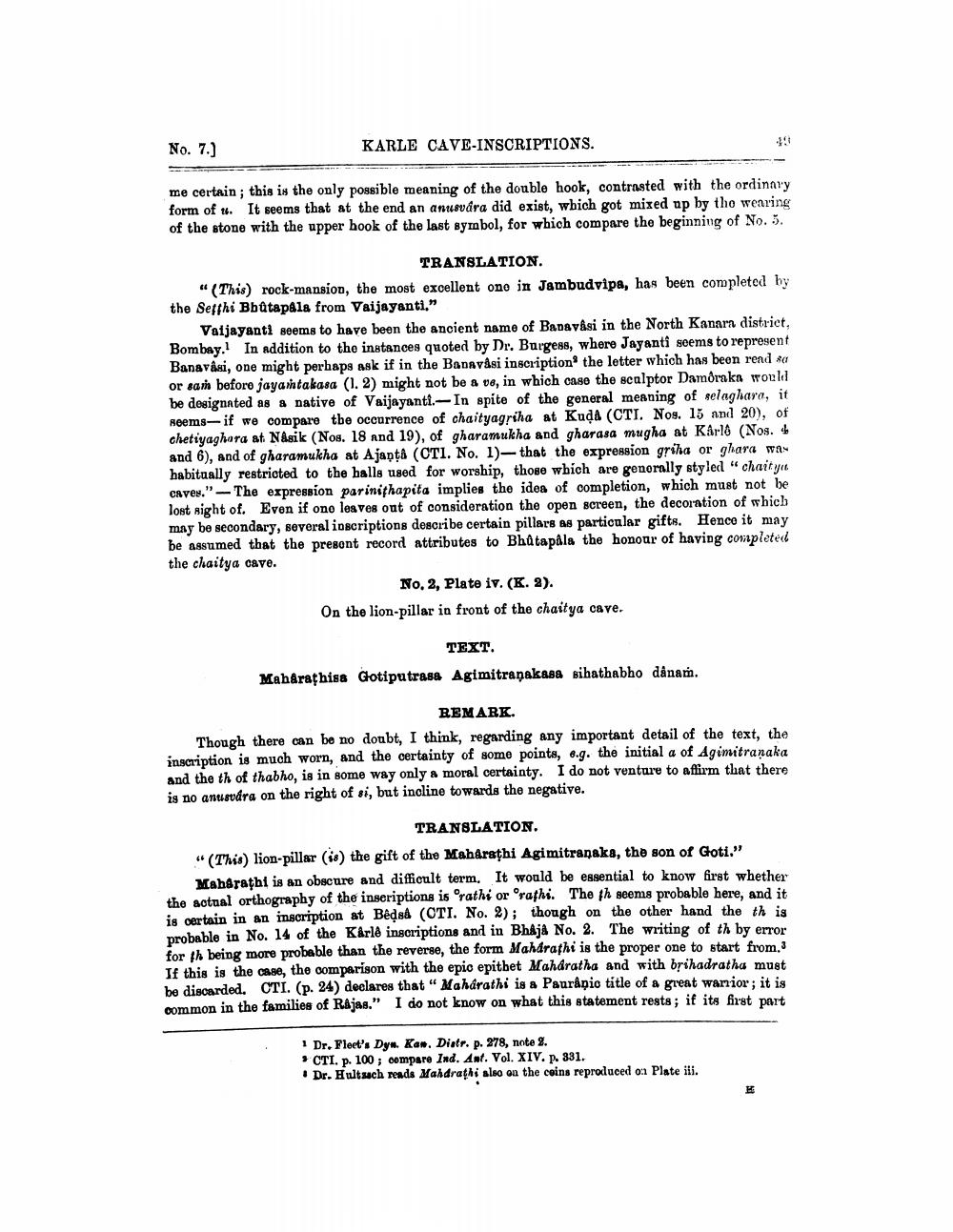________________
No. 7.)
KARLE CAVE-INSCRIPTIONS.
me certain; this is the only possible meaning of the double hook, contrasted with the ordinary form of u. It seems that at the end an anusvára did exist, which got mixed up by the wearing of the stone with the upper hook of the last symbol, for which compare the beginning of No. 5.
TRANSLATION.
"(This) rock-mansion, the most excellent one in Jambudvipa, has been completed by the Seffhi Bbûtapala from Vaijayanti,"
Vaijayanti seems to have been the ancient name of Banavâsi in the North Kanara district, Bombay. In addition to the instances quoted by Dr. Burgess, where Jayanti seems to represent Banavasi, one might perhaps ask if in the Banavasi inscription the letter which has been read sa or sam before jayamtakasa (1. 2) might not be a ve, in which case the sculptor Damôraka would be designated as a native of Vaijayanti.-In spite of the general meaning of selaghara, it seems-if we compare the occurrence of chaityagriha at Kuda (CTI. Nos. 15 and 20), of chetiyaghara at Nasik (Nos. 18 and 19), of gharamukha and gharasa mugha at Kârlo (Nos. 4 and 6), and of gharamukha at Ajanta (CTI. No. 1)-that the expression griha or ghara was habitually restricted to the halls used for worship, those which are generally styled "chaitya caves."The expression parinithapita implies the idea of completion, which must not be lost sight of. Even if one leaves out of consideration the open screen, the decoration of which may be secondary, several inscriptions describe certain pillars as particular gifts. Hence it may be assumed that the present record attributes to Bhâtapâla the honour of having completed the chaitya cave.
No. 2, Plate iv. (K. 2).
On the lion-pillar in front of the chaitya cave.
TEXT.
40
Maharathisa Gotiputrasa Agimitranakasa sihathabho dânam.
REMARK.
Though there can be no doubt, I think, regarding any important detail of the text, the inscription is much worn, and the certainty of some points, e.g. the initial a of Agimitranaka and the th of thabho, is in some way only a moral certainty. I do not venture to affirm that there is no anusvára on the right of si, but incline towards the negative.
TRANSLATION.
"(This) lion-pillar (is) the gift of the Maharathi Agimitranaka, the son of Goti."
Maharathi is an obscure and difficult term. It would be essential to know first whether the actual orthography of the inseriptions is rathi or rathi. The th seems probable here, and it is certain in an inscription at Bêḍså (OTI. No. 2); though on the other hand the th is probable in No. 14 of the Karlê inscriptions and in Bhaja No. 2. The writing of th by error for th being more probable than the reverse, the form Maharathi is the proper one to start from.3 If this is the case, the comparison with the epic epithet Maháratha and with brihadratha must be discarded. CTI. (p. 24) declares that "Maharathi is a Paurâpic title of a great warrior; it is common in the families of Rajas." I do not know on what this statement rests; if its first part
1 Dr. Fleet's Dyn. Kan. Distr. p. 278, note 2.
CTI. p. 100; compare Ind. Ant. Vol. XIV. p. 331.
Dr. Hultsach reads Mahdrathi also on the coins reproduced on Plate iii.
H




